CHILE
History

History

Cities in CHILE
| Santiago |
History
Pre-Columbian Chile
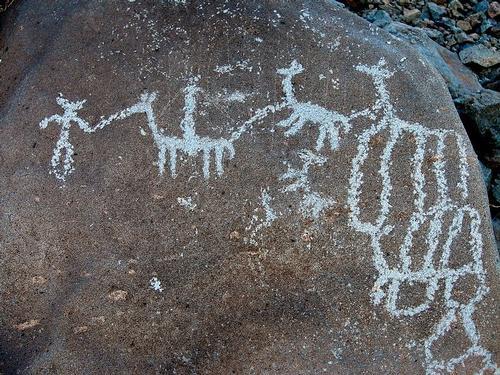
Approx. 20,000 years ago, nomadic hunters spread from Asia all over North and South America. It is believed that the first humans eventually reached Tierra del Fuego in southern Chile between 17,000 and 12,000 years ago. These hunters and gatherers traveled around and were never in a fixed place for long. Around 5000 BC. many people throughout South America turned to agriculture, growing cotton and corn, among other things. This change also happened in Northern Chile, in Southern Chile the inhabitants remained hunters and gatherers due to the climatic conditions.
Prehistoric Peoples
The first populations in northern Chile were nomadic fishermen, sierra people, valley Indians and Aymara Indians on the plateau. All these groups were in contact with each other and traded extensively.
An example of nomadic fishermen were the Changos who lived all along the coast of the Little and Great North. The Changos survived the arrival of the Europeans until the late 19th century.
The Atacameños were initially hunters, but gradually turned to sedentary farming and stood out for making irrigation systems and terraced farming. The Atacameños stood in the 12th century AD. at their peak in both agriculture and culture. The rise of the Incas and the arrival of the Europeans caused the decline of the Atacameños culture.
The Aymaras lived on the plateau and just north of the Atacameños. Today's Aymaras descend from western Amazonian peoples and flourished during the Inca Empire.
Until the arrival of the Incas, different periods can be distinguished within the above cultures of the Great North.
The archaic period lasted from 8000-1000 BC. and was dominated by the Chinchorro culture best known for its remarkable burial finds and mummified bodies, which are among the oldest in the world. The height of this culture was between 4000 and 2000 BC, and became 1000 BC. permanently supplanted by the "Faldas del Morro" culture, who first made pottery. This "pottery" period is called the formative period and was also devoted to making llamas and alpacas pets. This early ceramic period lasted from 1000 BC. to 300 AD.
After the formative period, the whole of Northern Chile was under great influence of the Tiwanaku Empire, the most important cultural and political center of the time, headquartered in the Bolivian plateau. During the late ceramic period from 1000 to 1470 several independent kingdoms arose in the north of Chile, defended by fortresses (Atacameños).
The archaic period in the Little North of Chile lasted from 8000-2000 BC. and also during this period hunters moved from the coast into the interior and then across the Andes. The heyday of the El Molle culture in the Elqui Valley is between 0-800 AD. These semi-permanent farmers are best known for their new way of making pottery.
When the El Molle culture disappeared, the area was taken over by the Diaguitas around 900, who took agriculture to a much higher level by developing all kinds of new techniques, metalworking and making very beautiful pottery.
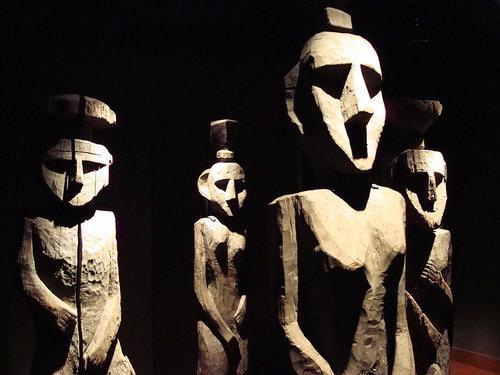
Of the earliest inhabitants in southern Chile, only the Mapuche or Araucanians survived the arrival of the Europeans. In the 12th century they moved from the Argentinian steppes over the Andes mountains to the forests of southern Chile. They were hunters, but they also cleared forests to grow crops such as maize, potatoes, beans and quinoa, a particular grain.
The small Tehuelche people lived on the Patagonian steppe east of the Andes mountain range and they are also called Aonikenk. They were real nomadic hunters forced by the harsh climate to move with the seasons.
The Chonos lived completely isolated, including on the archipelago of southern Chile. They were mainly fishermen, just like the people of Tierra del Fuego, who lived in the very south of Chile. When the explorer Magellan came to southern Chile, four Native American peoples lived here: the Haush or Manekenks and the Onas or Selk'nam were tribes that lived off hunting; the Yaghanes or Yamanas and the Alacalufes were mainly fishermen. These people of Tierra del Fuego were at a fairly low level of development, but knew their natural environment through and through, and had a rich religion that was peppered with legends and legends. It is remarkable that they wore very few clothes in the harsh, wet climate. When European settlers occupied Tierra del Fuego from 1881, it quickly happened to the Tierra del Fuego, partly due to diseases brought by the Europeans, but also due to ordinary massacres.
In the fifteenth century, the great Inca civilization developed in Central South America. From Peru they penetrated through the Atacama Desert into present-day Chile and conquered large parts of the country. Only the Mapuches in southern Chile managed to stop the Incas. At the time of the Incas, about 1 million people lived on what is now Chilean territory.
European conquerors, the "conquistadors"
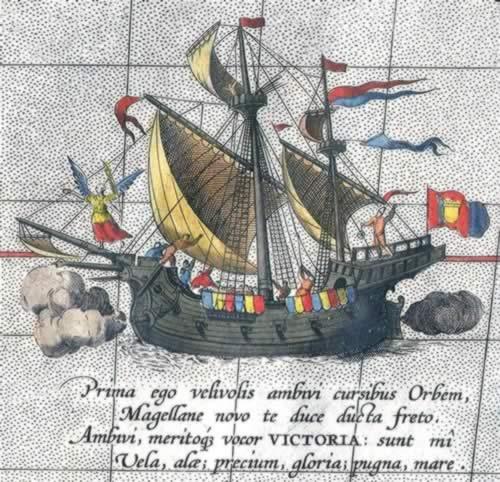
The southern tip of Chile was discovered by explorer Ferdinand Magelhaen in 1520. It was only after Peru was conquered from the Incas in the 1930s that the Spanish, led by Diego de Almagro, attempted to conquer Chile in 1536 mainly to find gold. However, both objectives were not achieved and it was not until 1541 that a new attempt was made. This attempt was made by Pedro de Valdivia, and he succeeded; Chile became a Spanish colony. De Valdivia did not waste any time and founded the cities of Santiago, Concepción, Valparaíso and Valdivia.
Chile was divided into so-called "encomiendas", large farms owned by large landowners and run by ex-soldiers and adventurers. The heavy work was of course done by Indians, who suffered badly from the Spanish occupation. Diseases unknown to the Indians broke out and many fled into the jungles or the mountains. As before, the Mapuches in the south held out against the Spanish for a long time, even into the 19th century.
In the 16th century, Chile was not yet economically interesting for the Spaniards and in 1700 the colony had only 100,000 inhabitants of European descent.
It was only after the development of agriculture and livestock farming in the 18th century that a period of economic growth began, which attracted many immigrants from Europe. The population now rose rapidly to over one million around 1800.
Independence struggle, Bernardo O'Higgins first president
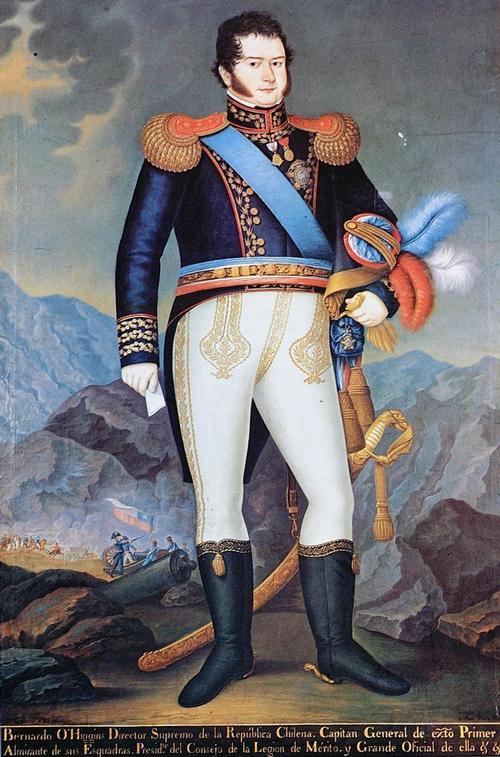
In the first half of the nineteenth, a struggle for independence breaks out in Chile, just like in the rest of South America. The liberal ideas originating from the French Revolution and the declaration of North American independence had a great influence on this. A kind of civil war broke out in Chile between the Spanish supporters and the autonomous people who were in favor of independence and were more than fed up with the Spanish influence in the administrative apparatus. The independence fighters were led by Irish-born Bernardo O'Higgins. He was assisted by Argentine troops, led by one of the "liberators" of South America, José de San Martin. The Spanish army was defeated by the autonomists at the Battle of Maipu, after which Chile gained independence in 1818 with O'Higgins as its first president. He designed a constitution that, however, came at the expense of the influence of the landowners and the church. Because of this he met so much resistance that he resigned in 1823. A very troubled period now followed with many uprisings and coups d'état.
Under Diego Portales, an authoritarian government came to power in 1833, in which the large landowners were actually in control. This meant a relatively stable period politically and economically, which was further reinforced by the development of an agricultural economy towards more and more income from trade and mining. The conservative policies of successive presidents increased tensions with more liberal movements. The 1871 constitutional revision changed the presidential election system somewhat, a small success for the liberals.
At the end of the nineteenth century, Chile turned its eyes to the guano and nitrate reserves in northern Peru and Bolivia. Chile annexed large parts of both countries in 1879 in the so-called "Pacific War" or "Nitric War". Chile did lose a large part of Patagonia to Argentina due to the efforts in the north. Chile also conquered the Easter Islands. The rebellious Mapuches were finally subjected to central authority and placed in reservations, where they still live in dire poverty. Finally, the south of Chile was also opened up and colonized, especially by thousands of Europeans who emigrated to Chile due to the population surplus in Europe. In the nineteenth century, large-scale investments were also made by England and especially Germany in the industry and mining of Chile.
Chile is the first parliamentary republic in South America
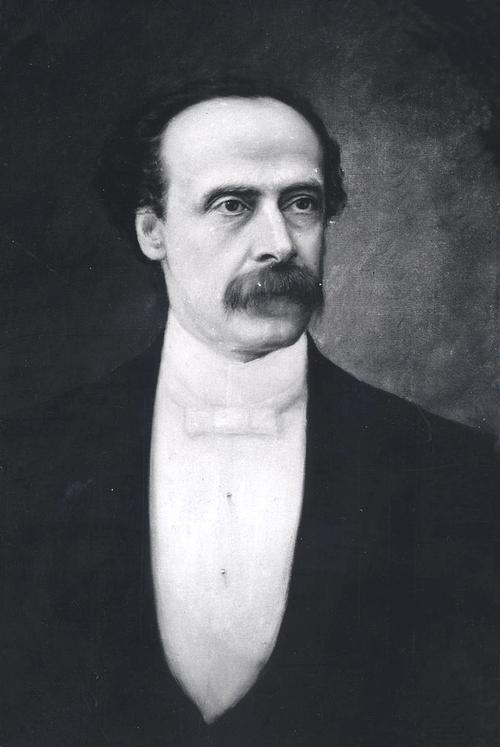 Chile Jose Manuel BalmecedaPhoto: Public domain
Chile Jose Manuel BalmecedaPhoto: Public domain
In 1884 universal suffrage was introduced in Chile and a parliament was formed, for the very first time in South America. The first democratically elected president was José Manuel Balmaceda Fernández (1886). He wanted to reduce dependence on British capital and a greater role for government in economic life. Congress rejected these plans and a governance crisis ensued, benefiting the fleet commander, Jorge Montt. He, along with his "Congressionalists", defeated government forces. Balmaceda committed suicide and Montt became the new president from 1891 to 1896. A kind of model democracy was now emerging in Chile, with good social services, good education and universal suffrage.
Economically, however, Chile failed to take advantage of this and remained a developing country in this area. The construction of the industry did not get off the ground at all and in fact it was completely dependent on nitrate exports, which were also completely in foreign hands. Dependence on one product became painfully evident when fertilizers were invented in 1914 and the nitrate trade completely collapsed. In the meantime, fortunately, the copper industry had picked up, but it was also in the hands of two American companies and dependent on the fluctuating prices on the world market. Moreover, the profits that were made largely disappeared abroad. Yet people still earned so much that social services could remain more or less intact. This changed in the 1930s when the global economic crisis also hit Chile hard and people had to start thinking about how to proceed now in the economic and social field.
In 1920, Arturo Alessandri was the first president who did not come from one of the wealthy families. With the help of the military, he was able to implement his reform plans, including restoration of the president's power, tax measures, and labor laws. In 1927, army officer Carlos Ibañez seized power and led dictatorial rule until 1931. In 1932 Alessandri succeeded in regaining power and then completed his term of office. The increased influence of the left was reflected in the election in 1938 as president of Pedro Aguirre Cerda, the candidate of the Popular Front. He improved education and stimulated industrialization.
The German-speaking minority managed to ensure that Chile remained neutral during the Second World War until January 1943; Chile then sided with the Allies. After the war, American influence became more and more evident. A law on the protection of democracy introduced by President Gabriel Videla (1946-1952) led to the dismissal of communist ministers and widespread persecution of members and sympathizers of the communist party. In the 1952 elections, the nationalist Ibañez was re-elected president. After the conservative government of Jorge Alessandri (1958-1964), Eduardo Frei came to power: for the first time a Christian Democratic president.
Period Salvador Allende
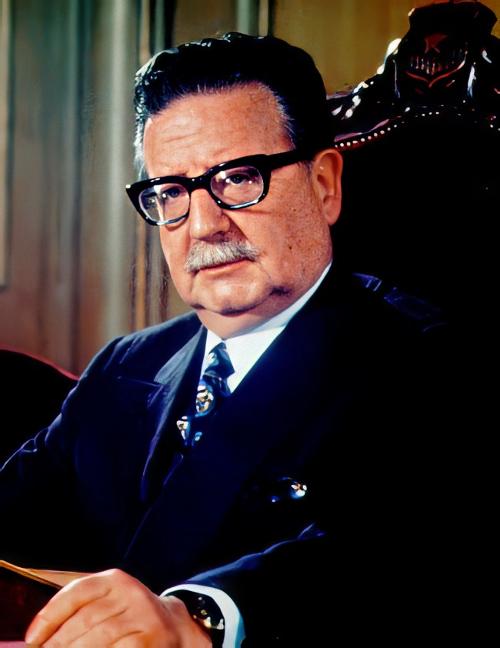 Salvador Allende ChilePhoto: Biblioteca del Congreso Nacional de Chile CC 3.0 Chile no changes made
Salvador Allende ChilePhoto: Biblioteca del Congreso Nacional de Chile CC 3.0 Chile no changes made
At the time, parliament was under constant control by conservative parties, but the many social inequalities created an active leftist movement that increasingly opposed the state of affairs in Chile. Real coups did not happen, and it was not until 1970 that the Marxist Salvador Allende Gossens came to power, as a candidate of the left-wing coalition Unidad Popular (People's Unity). At that time, the economy was back in a total doldrums and Allende wanted to rectify this by means of radical reforms. Those reforms included large-scale nationalization and, of course, redistribution of large landholdings. However, the opposition from the right-wing parties was very strong and only the copper mines were eventually nationalized. The United States also completely disagreed with the path that Allende had taken, and showed this, among other things, by an economic boycott.
The poorest sections of the population got a little better under Allende because land was indeed redistributed and education and social services received new impulses. However, these measures were disastrous for unity in the country. There was chaos due to illegal land occupation, terrorist actions by large landowners and attacks by reacting leftist groups. The people, however, wholeheartedly supported Allende and showed this in the elections in 1973, which were again won by Allende. This was the signal for the right to carry out a carefully planned coup d'état on September 11, 1973, with the help of the military and police, and with the backing of the United States.
Dictatorship under Pinochet
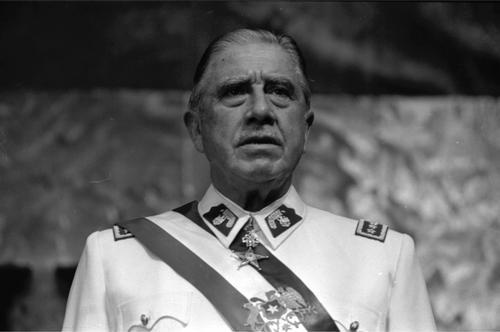
The Moneda Palace was bombed and Allende committed suicide. The 'Chilean experiment', which consisted in establishing socialism through a democratic and peaceful way, had lasted only three years, from November 1970 to September 1973. General Augusto Pinochet Ugarte became the leader of the military junta and held a very dictatorial rule, mainly based on terror. Torture was commonplace and political parties and trade unions were banned; many social measures were reversed. Many Chileans fled abroad or were exiled. In the countryside, there was murder by soldiers and landowners. Under Pinochet's rule, 20,000 were killed and tens of thousands were detained in concentration camps and torture centers. The military regime has been repeatedly condemned in the General Assembly of the United Nations for widespread and continuous violations of human rights. Relations with the United States reached an all-time low with the Carter administration's withdrawal of military and economic aid.
In 1980 there was a constitutional amendment that allowed Pinochet to remain in the saddle until at least 1989, only then would democratic elections be possible again. This eased the repression, which gave the people some courage, and in 1983, 1985 and 1986 mass strikes (15,000 arrests) followed, the so-called "protestas". In November 1984 martial law was even declared. These protests were also a result of the economic downturn. The church also got involved in this battle between the common man and the establishment. The guerrilla movement Patriotic Front Manuel Rodriguez (FPMR) committed an attack on Pinochet in September 1986. He again declared martial law and opposition leaders were arrested. The 1987 promulgation of the Voter Registration Act and the Political Parties Act once again allowed the legal functioning of opposition parties.
Growing discontent from initial supporters of Pinochet, as well as from abroad (especially the United States), forced Pinochet to call elections and Chile was on the verge of becoming a democracy again.
First of all, a referendum was held in October 1988 on the re-election of Pinochet. 55% of the population was against this and now nothing stood in the way of holding free elections.
Free elections: Patricio Aylwin president
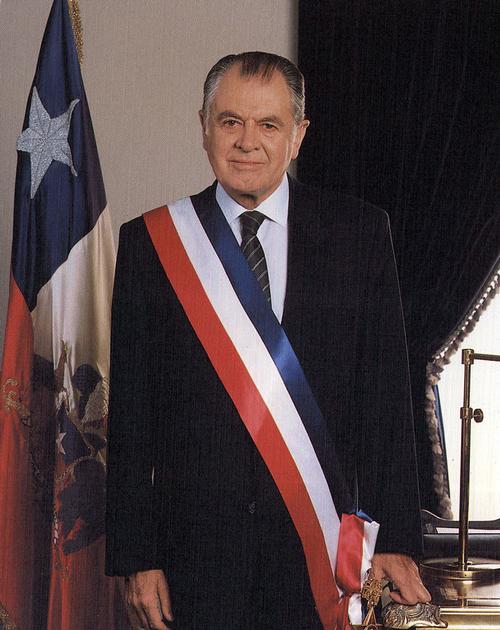 Patricio Aylwin ChilePhoto:Biblioteca del Congreso Nacional CC 3.0 Chili no changes made
Patricio Aylwin ChilePhoto:Biblioteca del Congreso Nacional CC 3.0 Chili no changes made
Meanwhile, the opposition had joined together and the December 17 presidential election was won by Christian Democratic leader Patricio Aylwin. After 17 years of military rule, Aylwin's assumption of office took place on March 11, 1990. Chile was the last country in South America to make the transition to a parliamentary presidential democracy. That was all the more bitter in the fact that there had been only two coups d'état in 150 years. Other South American countries had already completed dozens in the same time.
Furthermore, the transition went fairly smoothly due to the cautious approach of the government. A "Commission of Truth and Reconciliation" was also established to investigate the murders and disappearances during the Pinochet period. The committee's report came out in 1991 and was disastrous for Pinochet; 2,000 people murdered by police and military, 1,000 people "disappeared", and many were tortured and imprisoned. The perpetrators have still not been brought to trial by an amnesty law passed in 1987, and the military has not really cooperated in getting the bottom stone out.
In March 1994, Eduardo Frei Ruiz-Tagle took office as president. Privatization and modernization of governance, education and poverty reduction were high on his agenda. In the parliamentary elections at the end of 1997, the ruling Concertatión por la Democracía retained its majority in the House of Representatives.
21st century
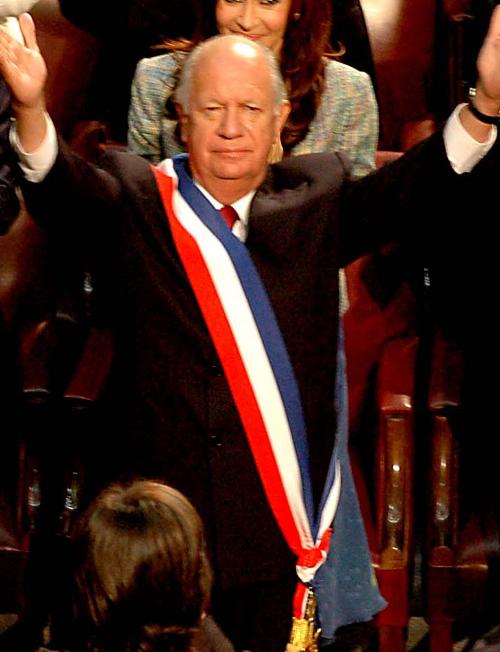 Ricardo Lagos ChilePhoto: Presidencia de la Nación Argentina CC 2.0 Generic no changes made
Ricardo Lagos ChilePhoto: Presidencia de la Nación Argentina CC 2.0 Generic no changes made
On January 16, 2000, Chilean voters elected moderate socialist Ricardo Lagos as president after a historic and fierce election battle. Lagos, a member of President Salvador Allende's former socialist government, became Chile's first socialist president since 1973. Lagos, a lawyer and former Minister of Public Works and Education, was a candidate for the ruling center-left coalition Concertación por la Democrácia.
The December 2005 presidential election required a second round. Socialist Michelle Bachelet took 46% of the vote, just not enough to win all at once. In the second round, Bachelet will face right-wing businessman and millionaire Sebastian Piñera on January 15, 2006, who received 25% of the vote. If Bachelet wins the second round, she will be Chile's first female president. In March, Bachelet was indeed sworn in as president. She won the second round of the election with 53% of the vote.
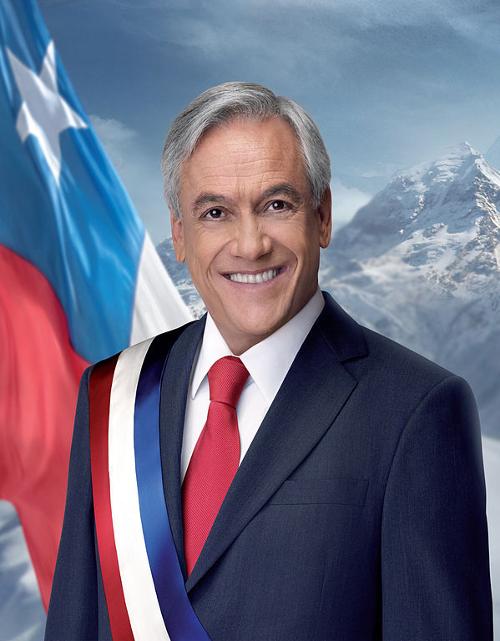 Chile Sebastian PiñeraPhoto: Government of Chile CC 3.0 Chile no changes made
Chile Sebastian PiñeraPhoto: Government of Chile CC 3.0 Chile no changes made
In December 2006, Chilean former dictator Pinochet died in a military hospital in the Chilean capital of Santiago. Pinochet was 91 years old. He had at least 130,000 arrested in the first three years of his rule alone. Many Chileans, an estimated 3000, disappeared without a trace or were killed. Tens of thousands fled their country. In June 2007, the government promised compensation to a number of victims of the Pinochet regime. Local elections in October 2008 indicate that the political right is on the rise. In February 2009, President Bachelet visits Cuba, for the first time in nearly 40 years that a Chilean head of government has visited Cuba. In January 2010, right-wing candidate Sebastian Pinera wins the presidential election, ending 20 years of left-wing coalitions. He will be sworn in in March 2010.
In October 2010, the mining drama in Chile comes to an end. 33 miners were trapped for 68 days after an explosion in a mine at a depth of more than 600 meters. The world watched intently as the miners were brought up one by one through a specially drilled shaft. Chilean President Sebastiaan Pinera received them and announced that Chile will ratify a 15-year-old international agreement on mine safety.
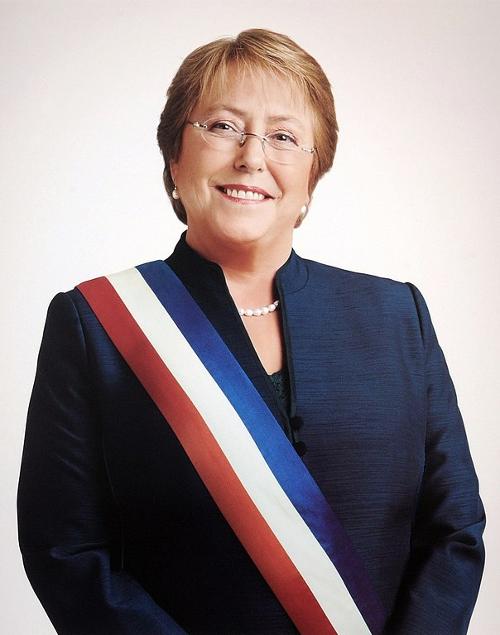 Chile Michelle BacheletPhoto:Gobierno de Chile CC 3.0 Chile no changes made
Chile Michelle BacheletPhoto:Gobierno de Chile CC 3.0 Chile no changes made
In December 2013, Michelle Bachelet wins the presidential election in the second round. In February 2015, President Bachelet announced plans to end the total ban on abortion. In December 2017, former president Sebastiaan Pinera wins the elections. He focuses on economic growth. At the end of 2019 there are massive protests against economic inequality. These protests were prompted by an increase in the price of metro tickets in Santiago, which was subsequently reversed. A referendum held on 25 October 2020 approved forming a convention to draft a new constitution (the current one was adopted during the rule of August Pinochet), and on 15-16 May 2021, a referendum was held to elect members to the convention.
Sources
Asal, S. / Chili
Lannoo.
Caistor, N. / Chili : mensen, politiek, economie, cultuur
Koninklijk Instituut voor de Tropen / Novib.
Castillo-Feliú, G.I. / Culture and customs of Chile
Greenwood Press.
Dwyer, C. / Chile
Chelsea House Publishers.
Filippo, H. / Chili
Elmar.
CIA - World Factbook.
BBC - Country Profiles.
Copyright: Team The World of Info